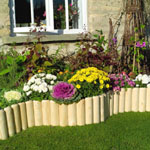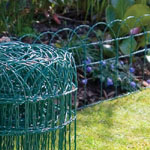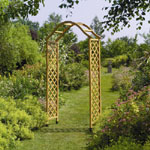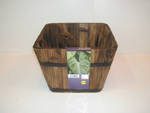
01757 28907301757 289073

York Garden Centre - No Retail Outlet Bowlands House, Ellerton, York, United Kingdom,
Gardening Guides
Gardening Jobs For March
Jobs for March
This is the first month of real activity in the garden, the start of the growing season. Dead heading of whatever winter flowers you have is a priority at this time to keep thing looking smart, and if like ours your snowdrops are only just starting to go over, these can be divided as soon as you remove the flowers and before the leaves die down.
In the vegetable garden it is time to dig or rotovate whenever the soil is dry enough, manure or fertilise or lime according to your crop rotation and once the soil temperature reaches 10oC start planting early crops. I covered my raised vegetable beds with black polythene in January and as a result they are not only dry enough to work but at 11oC they are 5o warmer than the wet clay soil in the rest of the garden.
It is the time also for sowing hardy annuals seeds outside, again when the soil reaches about 10oC. These are very useful for filling up empty spaces and will self seed to give you flowers in subsequent years. Half hardy annuals can be planted in the greenhouse or cold frame, or even a windowsill in the house, along with any brassicas that you are growing from seed.
I also buy any bedding or container plants in March and grow them on in the greenhouse so that by the end of May when they can be planted out they are already good sized plants and in flower.
The lawn will get its first cut sometime this month, a light trim is best for the first two cuts. Aeration is useful at this time, particularly if you have any areas that have been especially damp over the winter, or where there has been heavy traffic.
Deal with any weeds that have appeared before they start robbing your good plants of space, light or nutrients. Cut back all shrubs that flower from July onwards as well as roses and the coloured shoots of dogwood (cornus) and ribes that are so decorative in winter this will get you fresh brightly coloured growth for next winter.
This is the last chance to divide any mature perennials to keep them at their best. Finally cut back decorative grasses so that the fresh growth can come through
This is the first month of real activity in the garden, the start of the growing season. Dead heading of whatever winter flowers you have is a priority at this time to keep thing looking smart, and if like ours your snowdrops are only just starting to go over, these can be divided as soon as you remove the flowers and before the leaves die down.
In the vegetable garden it is time to dig or rotovate whenever the soil is dry enough, manure or fertilise or lime according to your crop rotation and once the soil temperature reaches 10oC start planting early crops. I covered my raised vegetable beds with black polythene in January and as a result they are not only dry enough to work but at 11oC they are 5o warmer than the wet clay soil in the rest of the garden.
It is the time also for sowing hardy annuals seeds outside, again when the soil reaches about 10oC. These are very useful for filling up empty spaces and will self seed to give you flowers in subsequent years. Half hardy annuals can be planted in the greenhouse or cold frame, or even a windowsill in the house, along with any brassicas that you are growing from seed.
I also buy any bedding or container plants in March and grow them on in the greenhouse so that by the end of May when they can be planted out they are already good sized plants and in flower.
The lawn will get its first cut sometime this month, a light trim is best for the first two cuts. Aeration is useful at this time, particularly if you have any areas that have been especially damp over the winter, or where there has been heavy traffic.
Deal with any weeds that have appeared before they start robbing your good plants of space, light or nutrients. Cut back all shrubs that flower from July onwards as well as roses and the coloured shoots of dogwood (cornus) and ribes that are so decorative in winter this will get you fresh brightly coloured growth for next winter.
This is the last chance to divide any mature perennials to keep them at their best. Finally cut back decorative grasses so that the fresh growth can come through
Landscaping
Hard landscaping has a habit of looking new when it is! If you want to age walls, concrete or flagstones, paint on a generous layer of a 50:50 mix of beer and yoghurt (details unimportant!). When it has dried in take some moss and, when the wife is out, put it in a kitchen blender with a goblet half full of water and blast to a sloppy pulp, then paint this on top of the beer/yoghurt mix. Very soon you will have distressed surfaces with moss and hopefully lichens growing.
If you leave out occasional flags, or even use flags where a bit is broken off, fill the gap with a plant, ideally one that will spread quickly over the edges – thyme is ideal –and this will also be useful in the kitchen and smell good if you walk on it.
Gravel can also be planted up with thyme or self seeding hardy annuals to make it look more established
Aim to get some height to your garden fairly quickly. If you don’t have fast growing trees or shrubs, consider an arch or large pyramid clad in a fast growing climber – honeysuckle, rose (investigate the differences between climbing and rambling roses)
Rustic garden furniture will always look well established. Second best in terms of looking as if it’s always been there is teak or other wooden furniture. Metal, plastic and glass will look new, but may well be more suitable for a modern town garden.
Finally get a number of pots and plant them up with whatever takes your fancy – but very early flowering and very late flowering plants always seem to be most useful. Don’t forget the possibility of herbs, strawberries or vegetables in your planter. These pots can either stand on a driveway or patio or can be used to fill in spaces in your planting to give the appearance of a well-established garden.
If you leave out occasional flags, or even use flags where a bit is broken off, fill the gap with a plant, ideally one that will spread quickly over the edges – thyme is ideal –and this will also be useful in the kitchen and smell good if you walk on it.
Gravel can also be planted up with thyme or self seeding hardy annuals to make it look more established
Aim to get some height to your garden fairly quickly. If you don’t have fast growing trees or shrubs, consider an arch or large pyramid clad in a fast growing climber – honeysuckle, rose (investigate the differences between climbing and rambling roses)
Rustic garden furniture will always look well established. Second best in terms of looking as if it’s always been there is teak or other wooden furniture. Metal, plastic and glass will look new, but may well be more suitable for a modern town garden.
Finally get a number of pots and plant them up with whatever takes your fancy – but very early flowering and very late flowering plants always seem to be most useful. Don’t forget the possibility of herbs, strawberries or vegetables in your planter. These pots can either stand on a driveway or patio or can be used to fill in spaces in your planting to give the appearance of a well-established garden.
Wall Planters
The time is here to be thinking about this year's display of container and hanging plants. We looked at how to make effective container displays a while ago, and many of the same points apply to containers which are attached to a wall.
First make sure that your wall is sound, and that there is no pointing missing, otherwise damp may penetrate the wall when you water the plants. Similarly be wary of wetting solid, single skin or rubble filled walls, but with any external wall of a house built within the last 75 years you can be certain that there will be a cavity and damp will not penetrate.
Many different types and designs of wall mounted containers are available.
When filling your container, use multipurpose potting compost mixed with water absorbing crystals and slow release fertiliser.
When choosing plants, obviously trailing and continuous flowering are important, but also try to give a thought to the overall effect - perhaps choosing plants of a limited colour range, or using the same upright plant (a bronze phormium for instance) in the centre of each container. Plant fairly densely otherwise your plants will spend most of the summer filling the containers up and your planting will look thin.
Ideally buy your plants now, plant them up into the containers now and keep them in a greenhouse (unheated) until very late May. By then the danger of frost should have gone and your plants will have nearly filled the container and should be just about to burst into flower so you will have a great display from day one. Remember that after 6 weeks your plants will have exhausted the food supply you gave them, so twice a week water with a diluted tomato fertiliser or similar
First make sure that your wall is sound, and that there is no pointing missing, otherwise damp may penetrate the wall when you water the plants. Similarly be wary of wetting solid, single skin or rubble filled walls, but with any external wall of a house built within the last 75 years you can be certain that there will be a cavity and damp will not penetrate.
Many different types and designs of wall mounted containers are available.
When filling your container, use multipurpose potting compost mixed with water absorbing crystals and slow release fertiliser.
When choosing plants, obviously trailing and continuous flowering are important, but also try to give a thought to the overall effect - perhaps choosing plants of a limited colour range, or using the same upright plant (a bronze phormium for instance) in the centre of each container. Plant fairly densely otherwise your plants will spend most of the summer filling the containers up and your planting will look thin.
Ideally buy your plants now, plant them up into the containers now and keep them in a greenhouse (unheated) until very late May. By then the danger of frost should have gone and your plants will have nearly filled the container and should be just about to burst into flower so you will have a great display from day one. Remember that after 6 weeks your plants will have exhausted the food supply you gave them, so twice a week water with a diluted tomato fertiliser or similar





